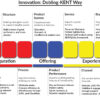
Healthcare executives frequently associate scale with tangible infrastructure: heavy hospital buildings, new-of-the-world operation theaters, latest scanners, and luxurious patient lounges. But as that saying goes, “what is essential is invisible to the eye.” Though walls, wards, and kit represent capacity, readiness is in the unseen—inflows, standard operating procedure (SOP) and escalation logic that characterize how care is indeed provided. In healthcare, frequently it is that unseen backbone that breaks or sustains operations.
Infrastructures against Readiness: Deciphering the Gap
Infrastructure is about tangible things—spaces, machines, and technology. Readiness is readiness to provide predictable, safe, and efficient care. It is about having well-articular clinical paths, emergency escalations, teams functioning in coordination mode, and a culture of responsibility.
To put it another way, a hospital might have a new ICU complete with latest-model ventilators. But without experienced staff to know rapid intubation protocol, cross-consultative paths, or blood gas monitoring work-flows, yet another ICU is an idle promise. As management sage Peter Drucker once noted, “Plans are only good intentions unless they immediately degenerate into hard work.” Infrastructures in healthcare are intention, readiness is implementation.
The Indian Model: Infrastructure Boom, Readiness Gap
India has experienced a bang in healthcare infrastructure, particularly through government efforts such as Ayushman Bharat Health Infrastructure Mission and expansion of hospitals by private players. Multi-specialty hospitals equipped with superior diagnostic facilities now dot even Tier-2 and Tier-3 cities. But preparedness is a gap that persists.Such as:
• A community that is small has a limited number of radiologists it can employ to work in its facilities.
• Patient flow is frustrated in a few private facilities through manual bottlenecks in registration even when electronic health records have been acquired.
• When India experienced its COVID-19 wave, oxygen plants were set up all over India, but hospitals found themselves battling pipelines of distribution and SOP of oxygen conservation—highlighting the readiness gap.
As Dr. Devi Shetty, founder of Narayana Health once stated, “India doesn’t need more hospitals, it needs hospitals that work like systems.”
International Perspective: Global System Lessons
Everywhere else in the world, the same gap is present, only differently. America, in its tremendous spending on healthcare, is an example of how high-end facilities do not necessarily mean preparedness. The 2020 COVID-19 epidemic revealed broken supply chains, disjointed ICU standards, and burst escalation systems even with high-end facilities.
Compare this to Singapore’s healthcare system, in which preparedness is baked into practice. Hospitals have regular mass casualty exercises, electronic triage flow is baked into practice, and escalation procedures are practiced. Facilities are in place, but its real strength is unleashed through unseen workflows.
Correspondingly, the UK’s NHS has strong SOPs but frequently experiences readiness difficulties through staffing gaps and bureaucratic slowdowns. Therefore, readiness necessitates as much protocol as sustained resourcing and flexibility.
The Invisible Elements of Readiness
1. Flows
Smooth operation is defined by efficient patient, information, and resource flow. Seaming less transition is required from triage to discharge. A bottleneck in a diagnostic can upset an whole list of surgery.
2. SOP
Standard operating procedures provide consistency. Whether it is blood transfusion or escalation of sepsis or even hand hygiene, SOPs make individual competency an aggregate reliability.
3. Escalation Logic
Readiness is proved upon crisis. Escalation logic responds: Who do you call first when a ventilator breaks? How does it make a code blue wake up cardiology? Without defined escalation maps, infrastructure becomes chaos.
Benefits of an Education of Readiness
1. Operational Efficiency: Smooth processes reduce downtime, make efficient use of resources, and lower expenditures.
Testimony: AIIMS Delhi’s computerized patient flow decreased outpatient wait time drastically.
2. Quality & Safety
SOPs minimize errors and variability. Checklists, as inaugurated by Atul Gawande, decreased surgical complications by almost a third internationally.
3. Resilience During Crises
Hospitals that have strong escalation logic ride out surges. Kerala’s preparedness—contact tracing flowsheet, ICU escalation protocol—during the pandemic was cited globally as a model.
Disadvantages and Problems
- Intangible and Difficult to Demon
As opposed to a gleaming new MRI machine, improvements in readiness are ugly and therefore more difficult to promote to investors or patients.
- Take Resources and Training
Construction of flows and SOPs is an ongoing staff education and leadership support requirement. Smaller hospitals might find it prohibitively expensive.
- Resistance to Change
Clinicians might interpret SOPs as oppressive. They have to weigh autonomy against standardization.
Advisory for Healthcare Leaders
• Audit the Invisible: Periodically review more than just infrastructure but escalation readiness and workflows. Simulate emergencies.
• Invest in People: Infrastructures depreciate, people’s skills appreciate. Constant training is readiness capital.
• Balance Exposure and Content: Promote your MRI, but make sure SOPs of its timely usage.
• Learn Across Borders: Take on best practices such as Singapore’s drills or flow redesign techniques of U.S. Institute of Healthcare Improvement.
Final thoughts
Outward infrastructure is the seen skeleton, but readiness is the unseen lifeblood. As Antoine de Saint-Exupéry once expressed in The Little Prince, “What is essential is invisible to the eye.” Hospitals that invest in the unseen—flow, SOPs, and escalation logic—turn capacity into capability. For a nation like India where healthcare demand exceeds supply, and indeed for all of us worldwide, readiness is a want that has been transformed into an absolute need.
In essence: A hospital with readiness but modest infrastructure can save lives. A hospital with infrastructure but no readiness can only save face.
Dr. Prahlada N.B
MBBS (JJMMC), MS (PGIMER, Chandigarh).
MBA in Healthcare & Hospital Management (BITS, Pilani),
Postgraduate Certificate in Technology Leadership and Innovation (MIT, USA)
Executive Programme in Strategic Management (IIM, Lucknow)
Senior Management Programme in Healthcare Management (IIM, Kozhikode)
Advanced Certificate in AI for Digital Health and Imaging Program (IISc, Bengaluru).
Senior Professor and former Head,
Department of ENT-Head & Neck Surgery, Skull Base Surgery, Cochlear Implant Surgery.
Basaveshwara Medical College & Hospital, Chitradurga, Karnataka, India.
My Vision: I don’t want to be a genius. I want to be a person with a bundle of experience.
My Mission: Help others achieve their life’s objectives in my presence or absence!
My Values: Creating value for others.
Leave a reply
















*Dear Dr. Prahlada N.B Sir,*
The *relationship between infrastructure and readiness in meeting patient care needs is crucial.* While infrastructure refers to the physical facilities, equipment, and technology, readiness is about the ability to provide predictable, safe, and efficient care. It's the unseen backbone of healthcare that includes well-articulated clinical paths, emergency escalations, and teams functioning in coordination mode.
*Key Aspects of Readiness :*
– *Flows*: Efficient patient, information, and resource flow are essential for smooth operations.
– *SOPs*: Standard operating procedures provide consistency and make individual competency an aggregate reliability.
– *Escalation Logic*: Defined escalation maps ensure that infrastructure doesn't become chaos during crises.
*Benefits of Readiness :*
– *Operational Efficiency*: Smooth processes reduce downtime, make efficient use of resources, and lower expenditures.
– *Quality & Safety*: SOPs minimize errors and variability.
– *Resilience During Crises*: Hospitals with strong escalation logic can ride out surges.
*Challenges and Solutions :*
– *Intangible and Difficult to Demonstrate*: Improvements in readiness can be hard to promote.
– *Resources and Training*: Ongoing staff education and leadership support are required.
– *Resistance to Change*: Clinicians may need to balance autonomy with standardization.
*Advisory for Healthcare Leaders:*
– *Audit the Invisible*: Periodically review escalation readiness and workflows.
– *Invest in People*: Constant training is readiness capital.
– *Balance Exposure and Content*: Promote infrastructure while ensuring SOPs are in place.
– *Learn Across Borders*: Adopt best practices from other healthcare systems.
Thank you for sharing valuable insights on the *importance of readiness in healthcare.* Your work is truly appreciated.
Reply